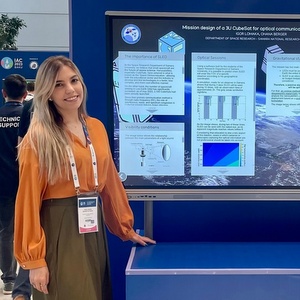This type of optical communication was once successfully used in the navy, where powerful signal searchlights were used to transmit messages from ship to ship. Along with Ohana Berger, a native of Brazil, young scientists from the Samara University took part in the research. They came to Russia from Mexico and Peru.
As part of this project, Ohana Berger and her colleagues, young scientists of the Interuniversity Department of Space Research at Samara University, under the guidance of Associate Professor Igor Lomaka, managed to mathematically show the feasibility of such an approach to message transmission and create a software package for automatically calculating the time of a communication session with such a nanosatellite, depending on the orbit of the spacecraft, the location of the observer, time of day and predicted weather conditions.
“Using the accumulated experience gained in doing this work, it has become possible at our Department to involve students and postgraduates in working on nanosatellite projects. This allows young people not only to get a theoretical education, but also to try themselves in real space missions. Thereby, students and postgraduates of the Interuniversity Department of Space Research participate in the design, testing, production and flight support of nanosatellites, are actively engaged in scientific activities and successfully speak at All-Russian and international conferences,” commented Igor Lomaka.
On the basis of the nanosatellite platform of the Interuniversity Department of Space Research, a 3U CubeSat (three-unit cubesat) nanosatellite project was developed, designed to experimentally test the effectiveness of this message transmission system from space. The designed spacecraft was named SAMSat-LED (SLED).SLED can be used in international educational projects, organizing optical communication sessions for young people from different countries. Such projects can bring together many young people around the world who are interested in astronomy and cosmonautics.
During the scientific research, the work of a nanosatellite with a “flashing light” in low Earth orbit with a height of about 400 km was considered. As calculations have shown, for consistent reception of the light “Morse code”, it is enough to equip the satellite with an LED module with a luminous flux of 12,000 lumens**. With an increase in the intensity of the luminous flux, the possibility of communication will increase accordingly, but energy consumption also increases. The theoretical calculations were verified using computer simulations and laboratory tests.
“The software automatically evaluates the possible quality of optical communication during periods of time when the nanosatellite is within the field of view of a particular observer according to its geographical coordinates. Of course, the best reception can be guaranteed in clear weather and at night, when the light “Morse code” with good eyesight can be seen even with the naked eye," Ohana Berger stressed.
In order for the nanosatellite to “tumble” in orbit as little as possible and for its LED module to face directly towards the Earth, the developers propose using a three-axis gravitational-aerodynamic stabilization system. The angular velocity that the nanosatellite gains when entering orbit is planned to be extinguished using a special algorithm created by scientists from the Interuniversity Department of Space Research.
For reference:
This project was presented in the form of a report “CubeSat educational nanosatellite project for testing SamSat-LED optical communication” at the symposium on small satellite missions of the 74th International Astronautical Congress in Baku, where it was highly appreciated and included in the list of the best reports made by students.
*Ohana Berger is one of the first Brazilian students to receive higher ”space” education in Russia. Having arrived in Russia in 2017, Ohana enrolled at Samara State University and successfully completed her bachelor’s degree in Rocket Systems and Cosmonautics in 2022, after which she continued her studies at the Master's degree program.
**Lumen is a unit of measurement of the luminous flux.
Samara University is a participant in the National Project “Science and Universities”.
 RU
RU  EN
EN  CN
CN  ES
ES 